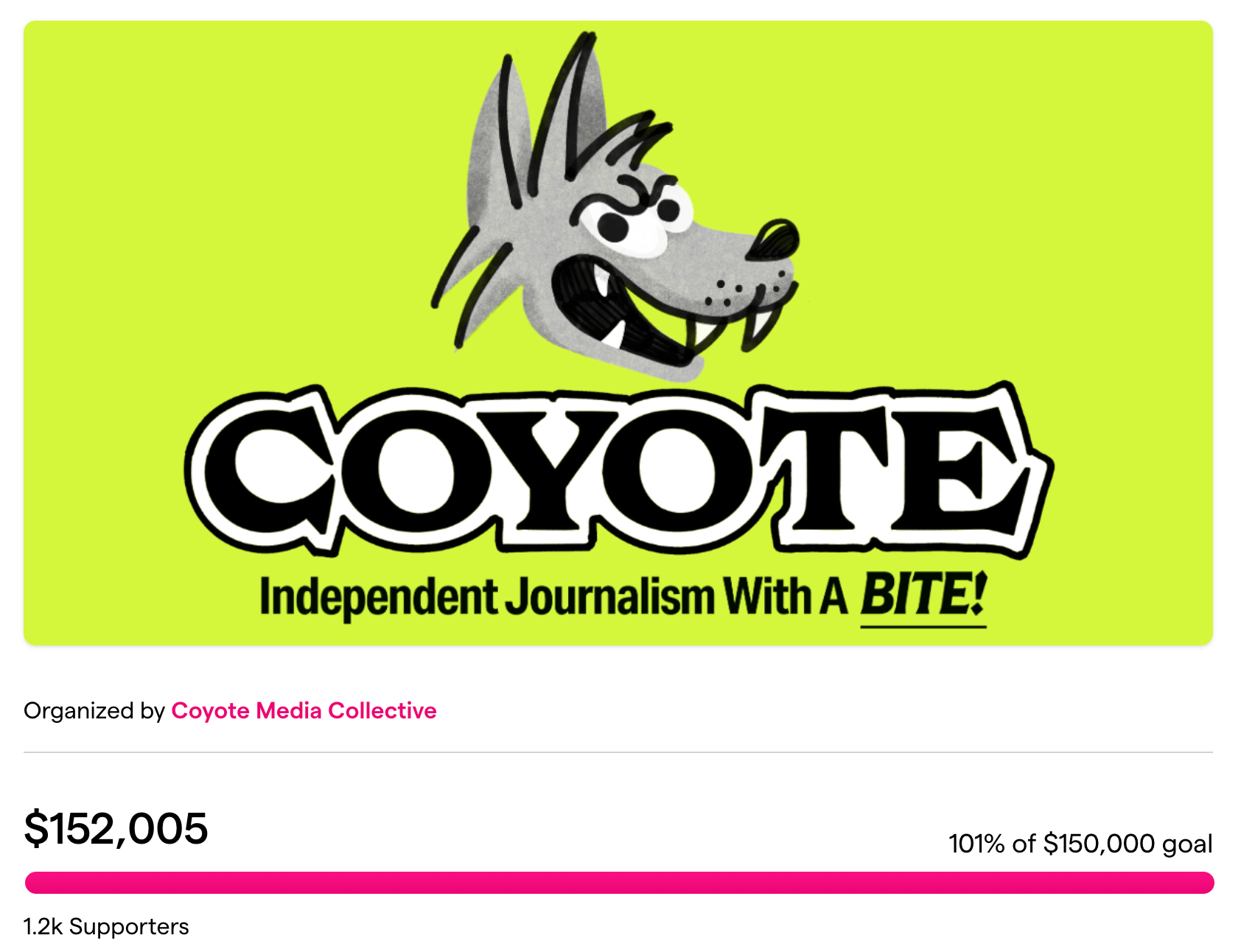
By Mark Glaser
With the devastating effects of corporate chains and hedge fund-owned local newspapers, there’s been a countervailing trend toward worker-led newsrooms, either as cooperatives, collectives or self-directed nonprofits. At Tiny News, there are now six worker-led newsrooms, including The 51st, COYOTE Media Collective, 505omatic, Southlander, Autonomy News and Kaheāwai Media — with more on the way.
As the field of worker-led newsrooms grows, often inspired by pioneers such as Defector Media, there’s still a lot of mystery about how these publishers operate, how they make decisions and how they become sustainable for the long term. I talked with Maddie Poore, one of the cofounders of The 51st (which serves Washington, D.C.), and Soleil Ho, a partner at COYOTE (which serves the San Francisco Bay Area), about their journeys launching their respective publications. The 51st took about 7 months from idea to launch; COYOTE took 11 months. So being deliberate can pay off.
Here are some of their tips for others who might want to do the same.
Before launching any publication, it’s crucial to research your community and what they need. The 51st spent time in every ward in Washington, D.C., at farmers markets and other local events, collecting information on what people wanted to see covered. They categorized that into a spreadsheet and even shared their findings in a story.

Alongside market research and community listening, worker-led newsrooms also have a lot of resources in the world of non-news coops. COYOTE and The 51st both leaned on documentation from the Sustainable Economies Law Center and the U.S. Federation of Worker Cooperatives. Soleil also mentioned taking a course from A Bookkeeping Cooperative. Maddie at The 51st said she spoke with the local Beloved Community Incubator and took a workshop through the BRED coop support organization in Baltimore for cooperative business fundamentals.
Maddie mentioned that one of the seven principles of cooperative businesses is “cooperation among cooperatives” so you can always call on others for advice. “We found pretty much everyone who worked at a cooperative newsroom or business was really, really down to talk with us, share resources, including policy manuals and incorporation documents,” she said. You won’t be surprised to hear that Soleil called on Maddie for advice before COYOTE launched.

Most people are familiar with conventional for-profit and nonprofit workplaces, but few have experience working inside co-ops, except perhaps from joining the local co-op market. Should you set up an LLC with a specific operating agreement like COYOTE did? Or perhaps a self-directed nonprofit like The 51st? The business structures are varied, so it’s important to figure out what feels right for your team and what classifications are recognized by the state where you are incorporated. Soleil said they worked out the LLC early on, with advice from accountants and tax experts.
And then comes the governance. Giving workers power to make decisions is exciting in theory but requires a sizable amount of collective planning and time management. Who decides who will be fired? Which decisions require a team vote vs. one person deciding? Maddie said that it helped having partners with aligned values. “[We have to] be really honest with each other and be down to share when things feel like they're not quite sitting right,” she said. “And not being precious about ideas or approaches — really leaving your ego behind. You want to have a spirit of cooperation when building something that works well for everyone.”
The 51st and COYOTE are located nearly 3,000 miles apart, but they have one big thing in common: They each ran a successful crowdfunding campaign pre-launch through Give Butter. The 51st raised more than $275,000 and COYOTE raised more than $150,000 to help launch their publications about a year apart.
Video produced by The 51st for its crowdfunding campaign
For startups without a lot of resources, but with good networks, this approach can help in many ways. It helps gauge interest, immediately builds a network of supporters (with contact info) and provides an injection of capital. Keep in mind that crowdfunding is one kind of fundraiser, and that other options are available.
Soleil said that COYOTE received advice from a development person who works with nonprofits, who helped them set goals, including a monetary goal for the campaign. The advisor also suggested a “soft launch” of the campaign with friends and family to seed the campaign with donations ahead of launch. COYOTE did some fun promotions on Instagram but needed some help. “We're all elder millennials, so we're not super comfortable with video as a social media thing,” Soleil said. “But we got some help from friends who are more fluent in that.”
The 51st chose Give Butter as a platform because it doesn’t take a percentage of money raised; you decide how much you want to tip them. It also helped that the community was heartbroken over the loss of DCist when the campaign launched, Maddie said. They ended up getting attention with a feature in the Washington Post and many other publications.
A worker-led structure offers many advantages for a newsroom. Independence from hierarchy, agency to make decisions, a feeling of camaraderie. But that freedom also leads to more responsibility for folks who have never had to think about the business of journalism or governance issues. As Maddie pointed out, people in traditional newsrooms are able to chalk up dysfunction to executive decision-makers. In worker-led newsrooms, “We have to work it out together, and our complaints have to be strategic, where we’re responsible for finding solutions.”
Plus, there’s only so much you can decide as a group, and only so many hours in the day in a busy newsroom. “We have a lot of nitty-gritty questions to consider,” Soleil said. “Governance is a big part of it: ‘Deciding how we decide’ and with how many votes… Having everyone knowing what everyone else makes, and knowing what’s in the budget, how much money we make or lose — it’s scary but empowering.”
The 51st is celebrating its first anniversary as a publication, and it’s still working out its governance. Maddie said it helps to have an experimental thought process and have continual iteration. They’ve had to adjust the frequency of team meetings and map out different ways of approving expenses. They now require expenditures of more than $2,000 be brought up for more input.
“Cooperatively run structures are a path forward when we're seeing systems collapse,” Maddie said. “We’re seeing these incredibly inequitably structured systems that are not working. I believe localized collective, collaborative, people-focused structures are, in every industry, what can move us forward to help us build a parallel system alongside the one that's collapsing.”

Mark Glaser is a communications consultant for Press Forward, Knight Foundation, Tiny News Collective and The Lenfest Institute, and was the founder and executive editor of MediaShift.org. He was formerly the director of business and program development for the New Mexico Local News Fund. He runs the Wind Power Media consultancy out of Santa Fe.
Sign up for our monthly newsletter for ongoing updates, announcements, and resources for newsroom entrepreneurs.